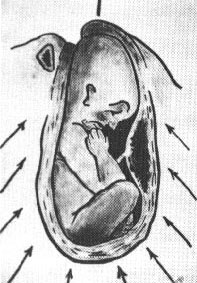
BPM III: – Sinergisme dengan Ibu. (Propulsion Melalui Terusan Lahir.)
Matriks ini berkaitan dengan tahap klinis kedua persalinan. Kontraksi rahim terus berlangsung, dan leher rahim terbuka lebar dan propulsi yang bertahap dan sulit melalui jalan lahir dimulai. Ada sebuah perjuangan yang sangat besar untuk bertahan hidup, dan tekanan mekanik.
BPM IV: – Pemisahan dari Ibu. (Pemutusan Uni simbiotik)
Matriks ini berkaitan dengan stadium klinis ketiga persalinan. Pada fase ini pengalaman menyakitkan selama beberapa jam memuncak, penggerak melalui jalan lahir selesai dan intensifikasi akhir dari ketegangan dan penderitaan diikuti dengan bantuan mendadak dan relaksasi.
Pengobatan Efektif
Pengobatan psikologis modern dapat membantu untuk memperbaiki kerusakan psikologis akibat kelahiran traumatis. Terapi seperti EFT [Teknik Emotional Freedom], dan Hypnotherapy .
Nah bagaimana agar Anak-Anak kita nanti tidak mengalami Birth Trauma ? kenalilah Gentle Birth dan ketahui Filosofinya. Dan semua tersedia di web site ini.
Salam hangat
Yesie Aprillia
Referensi:
- http://www.primal-page.com/grof.htm
- Chamberlain, David B. (1992). Is there intelligence before birth? Pre- and Perinatal Psychology Journal , 6 (3), 217-237.
- Emerson, William R. (1989). Psychotherapy with infants and children. Pre- and Perinatal Psychology Journal , 3 (3), 190-217.
- Frey II, William H., and Langseth, Margaret. (1985). Crying: The Mystery of Tears . Minneapolis: Winston Press, Inc.
- http://lorricraig.com/psychologist/general-psychology/difficult-birth-psychological-problems/
- Castellino, R. Cesarean Section Trauma, Impact and Treatment. Santa Barbara, Ca. (1105 N. Ontare, 93105), 1996.
- Chamberlain, DB “The Significance of Birth Memories.” Pre and Perinatal Psychology Journal, 2, 136-154.
- Emerson, W. and Schorr-Kon, S. Somatotrophic Therapy. In Innovative Therapy. London, Open University Press, 1993.
- Emerson, W. What is Birth Trauma? An Introductory Video Script. Petaluma, Emerson Training Seminars (4940 Bodega Ave., Petaluma, Ca. 94952), 1995.
- Feher, L. The Psychology of Birth: Foundation of Human Personality. Souvenir Press. 1980.
- Fodor, N. The Search for the Beloved: A Clinical Investigation of the Trauma of Birth and Prenatal Condition. Hermitage Press. 1949.
- Hendricks, G. & K. Hendricks. “Techniques for Dealing with Prenatal and Perinatal Issues in Therapy: A Bodymind Approach.” Pre- and Perinatal Psychology Journal 1(3): 230-38. 1987.
- Kitzinger, S. The Crying Baby. New York, Penguin Books, 1990.
- Laibow, RE “Birth Recall: A Clinical Report.” Pre- and Perinatal Psychology Journal 1(1): 78-81. 1986.
- Kohen, Nancy W. Silent Knife. New York, Bergin & Garvey, 1983.
- Kohen, Nancy W. Open Season. New York, Bergin & Garvey, 1991.
- LeBoyer, F. Birth without Violence. New York, Alfred A. Knopf, 1975.
- LeCron, LM “The Uncovering of Early Memories by Ideomotor Responses to Questioning.” International Journal of Clinical and Experimental Hypnosis 11(3): 137-42. 1963.
- Magid, K. & McKelvey, A. High Risk: Children Without a Conscience. Toronto, Bantam Books, 1987.
- Noble, E. Primal Connections: How our experiences from conception to birth influence our emotions, behavior, and health. New York, Simon Schuster, 1993.
- Peerbolte, M. Psychic Energy. Wassenaar, Servire Pubishers, 1975.
- Rank, O. The Trauma of Birth. Harcourt Brace. 1929.




